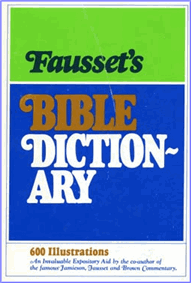Fausset's Bible Dictionary
A B C D E F G H I J K L M N O P Q R S T U V W X Y Z
Locust
(See JOEL ). The arbeh is the migratory devastating locust. The gowb , "grasshopper," is a species of gryllus, with voracity like the
migratory locust, but small in size (Smith’s Bible Dictionary makes gowb the nympha state of the locust): Amos 7:1. Nahum 3:17: "the
great grasshoppers (Hebrew the locust of locusts) which camp in the hedges in the cold day, but when the sun ariseth flee away," etc. The
locust lays its eggs under shelter of hedges; they are hatched by the sun’s heat in the spring; by June the young are so matured as to be
able to flee away. So Assyria shall disappear. The chagab is another of the Gryllidae (Numbers 13:33; Ecclesiastes 12:5); Isaiah 40:22,
"grasshopper," thus gowb = chagab . They all are Orthoptera with four wings; jaws strong and formed for biting. The hind limbs of the
saltatoria are largely developed, the thighs long and thick, the shanks still longer; thus "they have legs (the tibiae, so placed) above
their feet to leap withal upon the earth" (Leviticus 11:21). The migratory locust is two inches and a half long, the forewings brown and
black, and the thorax crested. Their devastations are vividly depicted (Exodus 10:15; Joel 2:3,5,10). The ‘ arbeh and the sol’am ("the
bald, smooth headed, locust," nowhere else mentioned; some of the winged orthopterous saltatoria; the Hebrew is related to the Egyptian
for "locust") and the grasshopper (chagab ) might be eaten (Leviticus 11). They are generally thrown alive into boiling water with salt,
the wings, legs, and heads being pulled off; the bodies taste like shrimps, and are roasted, baked, fried in butter, ground, pounded, and
mixed with flour for cakes, or smoked for after rise. For "beetle" (Leviticus 11:22) translate " chargowl ," some kind of the lo cust or
grasshopper "saltatoria," from the Arabic hardjal "to leap." The tsaltsal occurs only in Deuteronomy 28:42, the locust that makes a
shrill noise, from a root "to sound" (Gesenius), very destructive: one of the Cicadae. The "palmerworm" (gazam ) is probably the larva
state of the locust (Gesenius): Amos 4:9; Joel 1:4; 2:25. Septuagint translated "caterpillar" by which KJV translated chaciyl , which is
rather one of the winged Gryllidae = the consuming locust. Gazam is the gnawing locust, ‘ arbeh the swarming locust, yeleq the licking
locust (in Jeremiah 51:27 "the rough caterpillars" refer to the spinous nature of the tibiae) which is translated "caterpillar" also in
Psalm 105:34 , elsewhere "cankerworm." Locusts appear in swarms extending many miles and darkening the sunlight (Joel 2:10); like horses,
so that the Italians call them "cavaletta," little horse (Joel 2:4,5; Revelation 9:7,9); with a fearful noise; having no king (Proverbs
30:27); impossible to withstand in their progress; entering dwellings (Exodus 10:6; Joel 2:8-10); not flying by night (Nahum 3:17; Exodus
10:13 "morning"). Birds, as the locust bird, which is thought to be the rose-colored starling, devour them; the sea destroys more (verse
19). Their decaying bodies taint the air (Joel 2:20). Barrow (Travels, 257) says the stench of the bodies on the shore was smelt 150
miles off. Joel’s phrase "the northern army" implies that he means human invaders from the N., the point of entrance to the Assyrians and
Babylonians. Reichardt (Jewish Intelligence, Feb., 1867) notices the Hebrew letters of gazam = 50, exactly the number of years that the
Chaldees ruled the Jews from the temple’s destruction by Nebuchadnezzar, 588 B.C., to Babylon’s overthrow by Cyrus, 538 B.C. ‘ arbeh =
208, the period of Persia’s dominion over the Jews from 538 to 330 B.C., when Alexander overthrew Persia. yeleq = 140, the period of
Greek rule over the Jews from 330 to 190 B.C., when Antiochus Epiphanes, Israel’s persecutor, was overcome by the Roman L. Scipio.
chaciyl = 108, the exact number of years between 38 B.C., when Rome placed the Idumean Herod on the throne, and A.D. 70, when the Romans
destroyed Jerusalem and the Jewish nationality.
Bibliography Information
Fausset, Andrew Robert M.A., D.D., "Definition for 'locust' Fausset's Bible Dictionary".
bible-history.com - Fausset's; 1878.
Copyright Information
© Fausset's Bible Dictionary
Fausset's Bible Dictionary Home
Bible History Online Home
Bible Encyclopedia (ISBE)
Online Bible (KJV)
Naves Topical Bible
Smith's Bible Dictionary
Easton's Bible Dictionary
Schaff's Bible Dictionary
Fausset's Bible Dictionary
Matthew Henry Bible Commentary
Hitchcock's Bible Dictionary

Dr. A.R. Fausset
Popular and Trending:
Meaning and definition of fasting, what is fasting in the bible, fasting definition, why should I fast, the power of prayer and fasting, Location of Galilee, where was galilee in the bible?, fasting definition, Galilee region, cities of Galilee, Sea of Galilee, Definition of biblical fire, what is fire in the bible?, fire and brimstone, fire meaning, baking bread with fire, Definition of the biblical firmament in Genesis, what is the firmament in the bible?, was the firmament the third heaven, firmament meaning, did the firmament bring the flood of Noah?.
